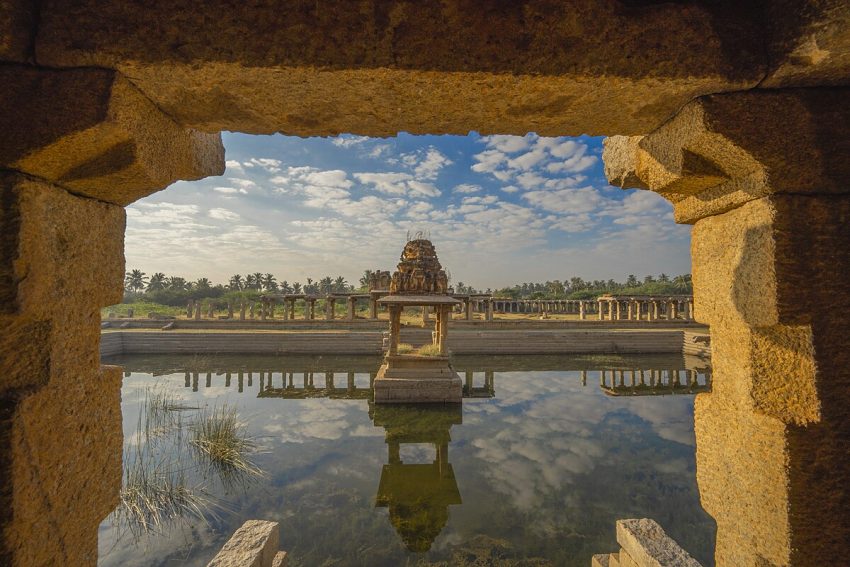Stepwells are architectural marvels that are a proof to India’s rich history and engineering skills. These ancient structures were designed to access groundwater in the dry regions of India, but over time, they became much more than just functional. They evolved into complex and beautiful pieces of art that attract travelers from all over the world. In this ultimate travel guide, we’ll explore the Top 10 Most Beautiful Stepwells in India and provide you with everything you need to know for your journey to these captivating sites.
Why Visit Stepwells?
Visiting stepwells in India is like stepping back in time. These structures are not just about their beauty; they tell stories of the past, showcasing the creative and artistic brilliance of ancient Indian architects and artisans. Here’s why you should add them to your travel bucket list:
- Historical Significance: Stepwells have been around since the 2nd and 3rd millennia BC. They played a crucial role in the daily lives of people in dry regions, providing water for drinking, bathing, and irrigation.
- Architectural Beauty: The complex carvings, symmetrical designs, and the sheer scale of these structures are awe-inspiring. They are perfect examples of ancient engineering and art.
- Cultural Experience: Visiting stepwells offers a unique cultural experience. You get to learn about the lifestyle, beliefs, and practices of the people who built and used these wells.
History of Stepwells
Stepwells, known as ‘baori‘ or ‘vav‘ in local languages, date back to ancient India. They were primarily constructed in the western parts of India, where water scarcity was a major issue. These wells were more than just water reservoirs; they were social hubs where people gathered, performed rituals, and sought respite from the heat.
Over centuries, stepwells evolved from simple pits in the ground to elaborate multi-storied structures adorned with sculptures and carvings. They reached their architectural zenith during the medieval period, particularly under the patronage of the Solanki dynasty in Gujarat and the Rajput rulers in Rajasthan.
Now, let’s dive into the Top 10 Most Beautiful Stepwells in India.
1. Chand Baori, Abhaneri, Rajasthan
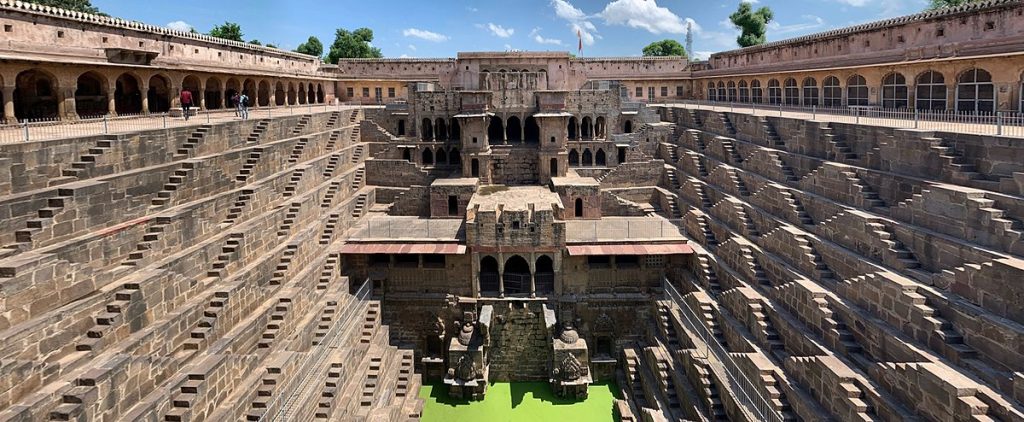
Chand Baori, located in the village of Abhaneri near Jaipur, is one of the most famous stepwells in India. Built during the 8th and 9th centuries by King Chanda of the Nikumbh dynasty, this stepwell is known for its stunning geometric design and intricate carvings.
Things to Do In & Around Chand Baori
- Explore the Stepwell: Walk down the 3,500 narrow steps arranged in perfect symmetry over 13 stories.
- Visit Harshat Mata Temple: Located right next to the stepwell, this ancient temple is dedicated to the goddess of joy and happiness.
- Photography: The play of light and shadow on the steps creates a mesmerizing effect, perfect for photography enthusiasts.
How to Get to Chand Baori
- By Air: The nearest airport is Jaipur International Airport, approximately 95 km away.
- By Train: The nearest railway station is Bandikui Junction, around 30 km from Abhaneri.
- By Road: Abhaneri is well-connected by road. You can hire a taxi or take a bus from Jaipur.
Best Time to Visit Chand Baori
The best time to visit Chand Baori is during the winter months (October to March) when the weather is pleasant.
Options to Stay
- Sariska Palace: A heritage hotel located near the Sariska National Park.
- Umaid Lake Palace: A beautiful resort offering comfortable accommodation and modern amenities.
Things to Know Before Visiting Chand Baori
- Timings: Chand Baori is open from 8 AM to 6 PM.
- Entry Fee: There is no entry fee to visit the stepwell.
- Guides: Local guides are available and can provide detailed information about the history and architecture.
Things to Avoid at Chand Baori
- Littering: Keep the site clean and dispose of waste properly.
- Vandalism: Do not scratch or deface the carvings and structures.
2. Rani-ki-Vav, Patan, Gujarat
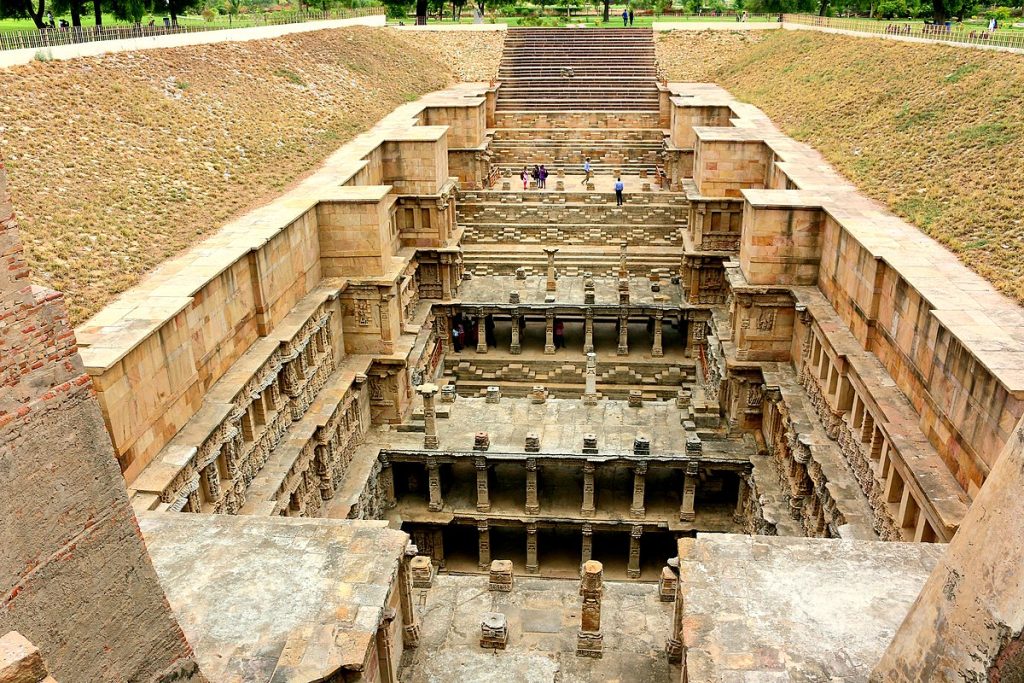
Rani-ki-Vav, or the Queen’s Stepwell, is an exquisite example of stepwell architecture. Built in the 11th century by Queen Udayamati in memory of her husband, King Bhimdev I, this UNESCO World Heritage Site is renowned for its ornate sculptures and intricate carvings.
Things to Do In & Around Rani-ki-Vav
- Explore the Stepwell: Admire the seven levels of stairs adorned with over 500 principal sculptures and numerous minor ones.
- Visit Patan: Explore the ancient town of Patan, known for its Patola sarees and historic Jain temples.
- Modhera Sun Temple: A short drive from Patan, this temple is dedicated to the Sun God and is another architectural marvel.
How to Get to Rani-ki-Vav
- By Air: The nearest airport is Sardar Vallabhbhai Patel International Airport in Ahmedabad, about 125 km away.
- By Train: The nearest railway station is Patan, well-connected to major cities in Gujarat.
- By Road: Patan is accessible by road from Ahmedabad, and regular buses and taxis are available.
Best Time to Visit Rani-ki-Vav
The best time to visit Rani-ki-Vav is from October to March when the weather is cool and comfortable.
Options to Stay
- The Grand Raveta: A comfortable hotel offering modern amenities.
- Patolia Heritage Hotel: A heritage property providing a glimpse into the local culture and lifestyle.
Things to Know Before Visiting Rani-ki-Vav
- Timings: The stepwell is open from 8 AM to 6 PM.
- Entry Fee: There is a nominal entry fee for both Indian and foreign tourists.
- Guides: Audio guides and local guides are available for a detailed tour.
Things to Avoid at Rani-ki-Vav
- Loud Noises: Maintain silence to preserve the tranquility and respect the heritage site.
- Touching Sculptures: Avoid touching the delicate sculptures to prevent damage.
3. Agrasen Ki Baoli, Delhi
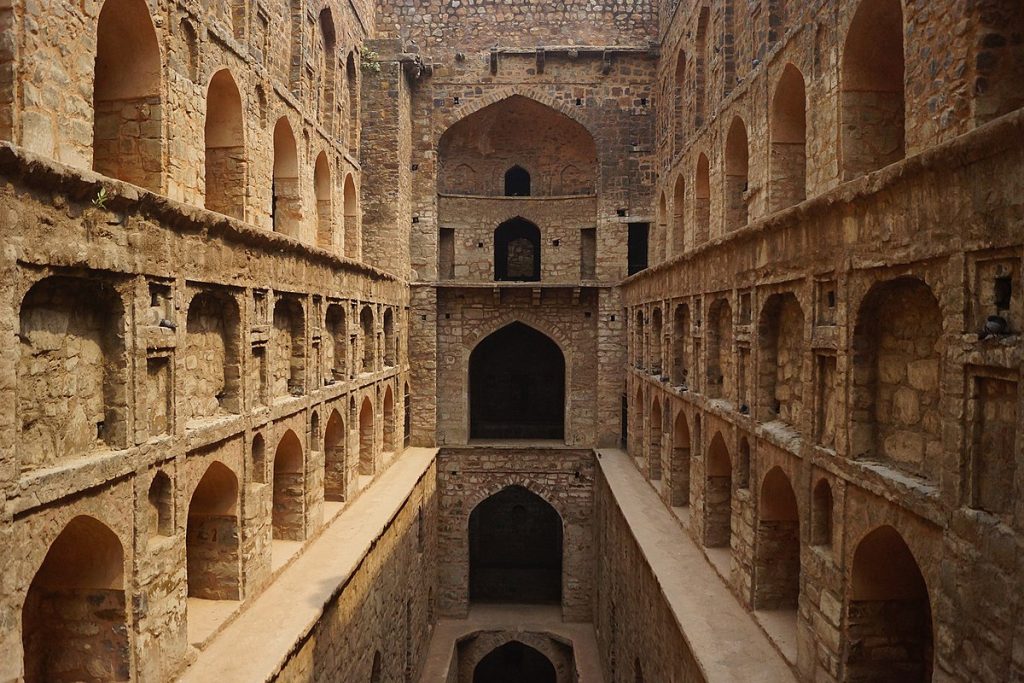
Agrasen Ki Baoli, an ancient stepwell located in the heart of Delhi, offers a tranquil escape from the city’s hustle and bustle. Believed to have been built by Maharaja Agrasen during the Mahabharata era and later rebuilt in the 14th century by the Agrawal community, this stepwell is a hidden gem amidst the urban chaos.
Things to Do In & Around Agrasen Ki Baoli
- Explore the Stepwell: Walk down the 108 steps and enjoy the serenity and cool atmosphere.
- Visit Connaught Place: A short walk away, this bustling commercial hub offers shopping, dining, and entertainment options.
- India Gate: A visit to the iconic India Gate, a war memorial, is a must when in Delhi.
How to Get to Agrasen Ki Baoli
- By Air: The nearest airport is Indira Gandhi International Airport, about 15 km away.
- By Train: New Delhi Railway Station is the closest, around 2 km away.
- By Metro: The nearest metro station is Barakhamba Road, just a short walk from the stepwell.
Best Time to Visit Agrasen Ki Baoli
The best time to visit Agrasen Ki Baoli is during the winter months (October to March) when the weather is pleasant.
Options to Stay
- The Lalit New Delhi: A luxury hotel offering world-class amenities.
- Connaught Royale: A mid-range hotel with comfortable rooms and good service.
Things to Know Before Visiting Agrasen Ki Baoli
- Timings: The stepwell is open from 9 AM to 5:30 PM.
- Entry Fee: There is no entry fee to visit Agrasen Ki Baoli.
- Guides: Local guides are available for a detailed tour.
Things to Avoid at Agrasen Ki Baoli
- Littering: Keep the area clean and dispose of waste properly.
- Vandalism: Do not deface the structures or carvings.
4. Adalaj Vav, Adalaj, Gujarat
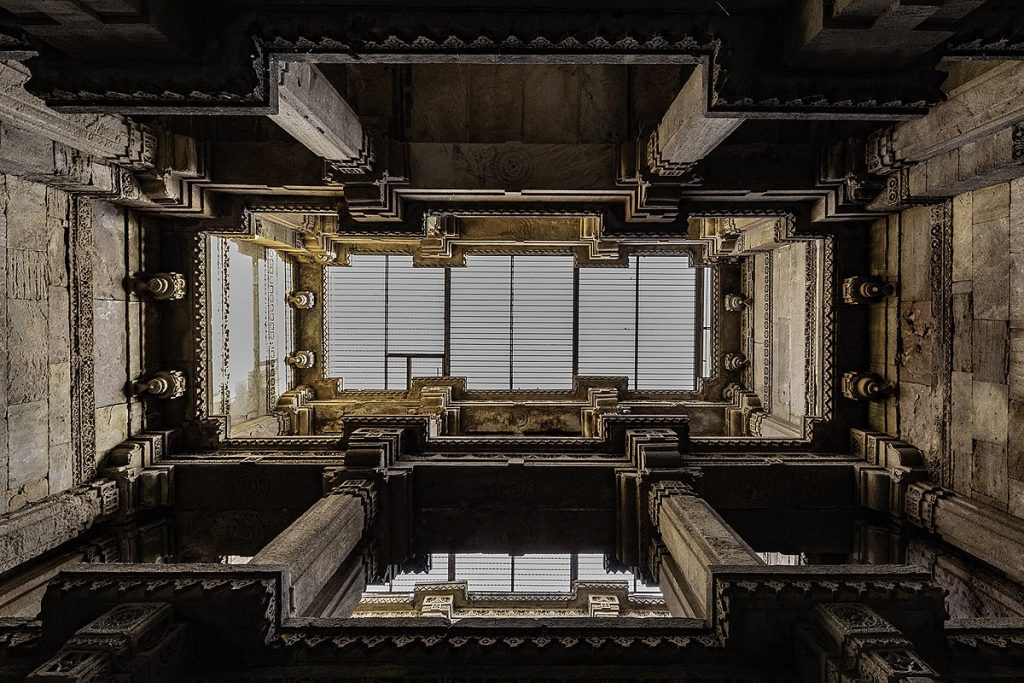
Adalaj Vav is a beautifully carved stepwell located in the village of Adalaj, near Ahmedabad. Built in 1498 by Queen Rudabai, wife of the Vaghela chief Veer Singh, this five-story stepwell is an architectural masterpiece blending Indo-Islamic design.
Things to Do In & Around Adalaj Vav
- Explore the Stepwell: Marvel at the intricate carvings depicting mythological scenes and floral patterns.
- Visit Gandhinagar: Explore the nearby city of Gandhinagar, the capital of Gujarat, known for its Akshardham Temple.
- Ahmedabad: Discover the rich cultural heritage of Ahmedabad, including the Sabarmati Ashram and the Kite Museum.
How to Get to Adalaj Vav
- By Air: The nearest airport is Sardar Vallabhbhai Patel International Airport in Ahmedabad, about 18 km away.
- By Train: The nearest railway station is Gandhinagar Capital, around 8 km from Adalaj.
- By Road: Adalaj is well-connected by road, and you can hire a taxi or take a bus from Ahmedabad.
Best Time to Visit Adalaj Vav
The best time to visit Adalaj Vav is from October to March when the weather is cool and pleasant.
Options to Stay
- Cambay Sapphire: A comfortable hotel offering modern amenities.
- Fortune Inn Haveli: A well-known hotel in Gandhinagar providing good service and accommodation.
Things to Know Before Visiting Adalaj Vav
- Timings: The stepwell is open from 6 AM to 6 PM.
- Entry Fee: There is no entry fee to visit Adalaj Vav.
- Guides: Local guides are available for a detailed tour.
Things to Avoid at Adalaj Vav
- Touching Carvings: Avoid touching the delicate carvings to prevent damage.
- Littering: Keep the site clean and dispose of waste properly.
5. The Pushkarinis of Hampi, Karnataka

Hampi, a UNESCO World Heritage Site, is known for its rich history and stunning architecture, including its one of the most beautiful stepwells in India, known as Pushkarinis. These stepwells were part of the Vijayanagara Empire and were used for various purposes, including religious rituals and daily water needs.
Things to Do In & Around The Pushkarinis of Hampi
- Explore the Stepwells: Discover the various stepwells spread across the Hampi ruins, each with unique designs.
- Visit Virupaksha Temple: One of the oldest temples in India, dedicated to Lord Shiva.
- Hampi Bazaar: Explore the bustling market area, filled with shops and eateries.
How to Get to The Pushkarinis of Hampi
- By Air: The nearest airport is Hubli Airport, about 160 km away.
- By Train: The nearest railway station is Hospet Junction, around 13 km from Hampi.
- By Road: Hampi is well-connected by road, and you can hire a taxi or take a bus from Hospet.
Best Time to Visit The Pushkarinis of Hampi
The best time to visit Hampi is from November to February when the weather is cool and pleasant.
Options to Stay
- Heritage Resort Hampi: A luxury resort offering comfortable accommodation and modern amenities.
- Clarks Inn Hampi: A mid-range hotel providing good service and comfortable rooms.
Things to Know Before Visiting The Pushkarinis of Hampi
- Timings: The Hampi ruins, including the stepwells, are open from sunrise to sunset.
- Entry Fee: There is a nominal entry fee for visiting the Hampi ruins.
- Guides: Local guides are available for a detailed tour.
Things to Avoid at The Pushkarinis of Hampi
- Climbing on Structures: Avoid climbing on the ancient structures to prevent damage.
- Littering: Keep the site clean and dispose of waste properly.
6. Rajon Ki Baoli, Delhi

Rajon Ki Baoli, located in the Mehrauli Archaeological Park in Delhi, is a beautiful stepwell built during the Lodi dynasty in the early 16th century. Named after the masons (rajon) who worked on it, this stepwell is a serene spot amidst the bustling city.
Things to Do In & Around Rajon Ki Baoli
- Explore the Stepwell: Walk down the steps and enjoy the peaceful ambiance.
- Mehrauli Archaeological Park: Discover the various historical structures within the park, including tombs and mosques.
- Qutub Minar: Visit the iconic Qutub Minar, a UNESCO World Heritage Site, located nearby.
How to Get to Rajon Ki Baoli
- By Air: The nearest airport is Indira Gandhi International Airport, about 15 km away.
- By Train: The nearest railway station is New Delhi Railway Station, around 16 km away.
- By Metro: The nearest metro station is Qutub Minar, just a short walk from the stepwell.
Best Time to Visit Rajon Ki Baoli
The best time to visit Rajon Ki Baoli is during the winter months (October to March) when the weather is pleasant.
Options to Stay
- The Leela Palace New Delhi: A luxury hotel offering world-class amenities.
- Hotel Saket 27: A mid-range hotel with comfortable rooms and good service.
Things to Know Before Visiting Rajon Ki Baoli
- Timings: The stepwell is open from 6 AM to 6 PM.
- Entry Fee: There is no entry fee to visit Rajon Ki Baoli.
- Guides: Local guides are available for a detailed tour.
Things to Avoid at Rajon Ki Baoli
- Littering: Keep the area clean and dispose of waste properly.
- Vandalism: Do not deface the structures or carvings.
7. Surya Kund Stepwell, Modhera, Gujarat

Surya Kund Stepwell, located near the Sun Temple in Modhera, is an architectural marvel from the Solanki dynasty era. This intricately designed stepwell was built to provide water for the temple rituals and is a stunning example of ancient engineering.
Things to Do In & Around Surya Kund Stepwell
- Explore the Stepwell: Admire the symmetrical design and detailed carvings on the steps and walls.
- Sun Temple: Visit the nearby Sun Temple, dedicated to the Sun God, and explore its beautiful architecture.
- Modhera Dance Festival: If visiting in January, don’t miss the Modhera Dance Festival, showcasing classical dance performances.
How to Get to Surya Kund Stepwell
- By Air: The nearest airport is Sardar Vallabhbhai Patel International Airport in Ahmedabad, about 100 km away.
- By Train: The nearest railway station is Mehsana, around 25 km from Modhera.
- By Road: Modhera is well-connected by road, and you can hire a taxi or take a bus from Ahmedabad.
Best Time to Visit Surya Kund Stepwell
The best time to visit Surya Kund Stepwell is from October to March when the weather is cool and pleasant.
Options to Stay
- Deshna Homestay: A comfortable homestay offering a cozy stay and local hospitality.
- Hotel Sun Plaza: A mid-range hotel providing good service and comfortable rooms.
Things to Know Before Visiting Surya Kund Stepwell
- Timings: The stepwell is open from 6 AM to 6 PM.
- Entry Fee: There is no entry fee to visit Surya Kund Stepwell.
- Guides: Local guides are available for a detailed tour.
Things to Avoid at Surya Kund Stepwell
- Touching Carvings: Avoid touching the delicate carvings to prevent damage.
- Littering: Keep the site clean and dispose of waste properly.
8. Panna Meena Ka Kund, Jaipur, Rajasthan
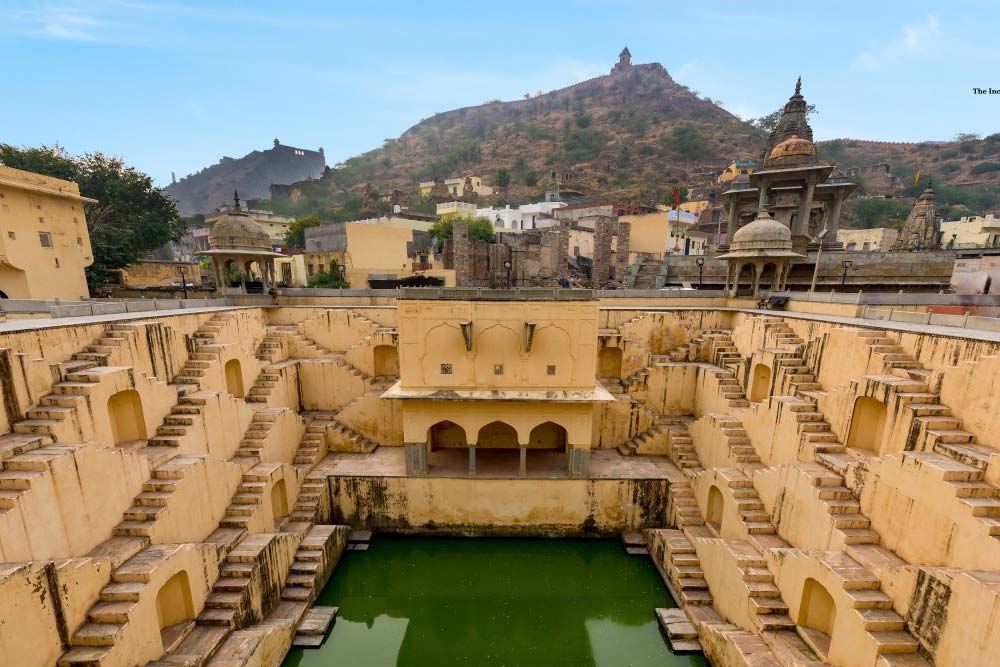
Panna Meena Ka Kund, located near the Amber Fort in Jaipur, is a picturesque stepwell built in the 16th century. This one of the most beautiful stepwells in India is known for its unique criss-cross step pattern and is a favorite spot for photographers.
Things to Do In & Around Panna Meena Ka Kund
- Explore the Stepwell: Walk down the steps and enjoy the cool ambiance.
- Amber Fort: Visit the nearby Amber Fort, a stunning example of Rajput architecture.
- Jal Mahal: Explore the beautiful Jal Mahal, a palace located in the middle of Man Sagar Lake.
How to Get to Panna Meena Ka Kund
- By Air: The nearest airport is Jaipur International Airport, about 20 km away.
- By Train: The nearest railway station is Jaipur Junction, around 10 km from Amer.
- By Road: Amer is well-connected by road, and you can hire a taxi or take a bus from Jaipur.
Best Time to Visit Panna Meena Ka Kund
The best time to visit Panna Meena Ka Kund is from October to March when the weather is cool and pleasant.
Options to Stay
- Trident Jaipur: A luxury hotel offering world-class amenities and stunning views of the lake and the Aravalli Hills.
- Hotel Amer View: A budget-friendly hotel providing comfortable accommodation and good service.
Things to Know Before Visiting Panna Meena Ka Kund
- Timings: The stepwell is open from 6 AM to 6 PM.
- Entry Fee: There is no entry fee to visit Panna Meena Ka Kund.
- Guides: Local guides are available for a detailed tour.
Things to Avoid at Panna Meena Ka Kund
- Littering: Keep the area clean and dispose of waste properly.
- Vandalism: Do not deface the structures or carvings.
9. Toorji Ka Jhalra, Jodhpur, Rajasthan

Toorji Ka Jhalra Bavdi, located in the heart of Jodhpur, is a beautifully restored stepwell dating back to the 18th century. Built by Queen Maharaja Abhay Singh’s consort, this stepwell showcases intricate carvings and stunning architecture.
Things to Do In & Around Toorji Ka Jhalra Bavdi
- Explore the Stepwell: Walk down the steps and enjoy the cool atmosphere.
- Mehrangarh Fort: Visit the nearby Mehrangarh Fort
, one of the largest forts in India, offering panoramic views of Jodhpur.
- Clock Tower and Sardar Market: Explore the bustling market area, filled with shops and eateries.
How to Get to Toorji Ka Jhalra Bavdi
- By Air: The nearest airport is Jodhpur Airport, about 6 km away.
- By Train: The nearest railway station is Jodhpur Junction, around 2 km from the stepwell.
- By Road: Jodhpur is well-connected by road, and you can hire a taxi or take a bus from nearby cities.
Best Time to Visit Toorji Ka Jhalra Bavdi
The best time to visit Toorji Ka Jhalra Bavdi is from October to March when the weather is cool and pleasant.
Options to Stay
- RAAS Jodhpur: A luxury hotel offering world-class amenities and stunning views of Mehrangarh Fort.
- Haveli Inn Pal: A heritage hotel providing comfortable accommodation and good service.
Things to Know Before Visiting Toorji Ka Jhalra Bavdi
- Timings: The stepwell is open from 6 AM to 6 PM.
- Entry Fee: There is no entry fee to visit Toorji Ka Jhalra Bavdi.
- Guides: Local guides are available for a detailed tour.
Things to Avoid at Toorji Ka Jhalra Bavdi
- Littering: Keep the area clean and dispose of waste properly.
- Vandalism: Do not deface the structures or carvings.
10. Dada Harir Stepwell, Ahmedabad, Gujarat
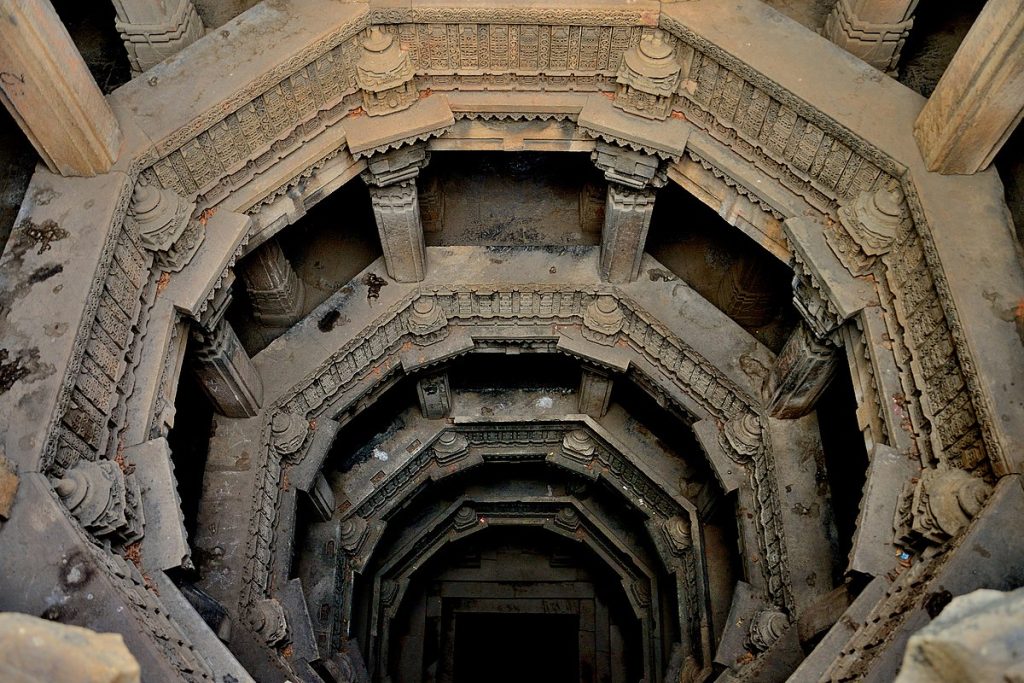
Dada Harir Stepwell, located in the city of Ahmedabad, is a stunning five-story stepwell built in the 15th century by a woman named Dhai Harir. This one of the most beautiful stepwells in India is an excellent example of Indo-Islamic architecture and features intricate carvings and stunning stonework.
Things to Do In & Around Dada Harir Stepwell
- Explore the Stepwell: Admire the intricate carvings and the symmetrical design of the stepwell.
- Visit the Jama Masjid: Located nearby, this mosque is one of the largest in India and a must-visit.
- Sabarmati Ashram: Explore the historic ashram where Mahatma Gandhi lived and worked.
How to Get to Dada Harir Stepwell
- By Air: The nearest airport is Sardar Vallabhbhai Patel International Airport in Ahmedabad, about 8 km away.
- By Train: The nearest railway station is Ahmedabad Junction, around 6 km from the stepwell.
- By Road: Ahmedabad is well-connected by road, and you can hire a taxi or take a bus from nearby cities.
Best Time to Visit Dada Harir Stepwell
The best time to visit Dada Harir Stepwell is from October to March when the weather is cool and pleasant.
Options to Stay
- Hyatt Regency Ahmedabad: A luxury hotel offering world-class amenities and comfortable accommodation.
- Lemon Tree Premier: A mid-range hotel providing good service and comfortable rooms.
Things to Know Before Visiting Dada Harir Stepwell
- Timings: The stepwell is open from 6 AM to 6 PM.
- Entry Fee: There is no entry fee to visit Dada Harir Stepwell.
- Guides: Local guides are available for a detailed tour.
Things to Avoid at Dada Harir Stepwell
- Touching Carvings: Avoid touching the delicate carvings to prevent damage.
- Littering: Keep the site clean and dispose of waste properly.
Conclusion – Most Beautiful Stepwells in India
The Most Beautiful Stepwells in India are not just architectural marvels but also historical treasures that offer a glimpse into the ingenuity and artistry of ancient India. From the stunning symmetry of Chand Baori to the intricate carvings of Rani-ki-Vav, each stepwell has a unique story to tell. Visiting these stepwells is a journey through time, offering a chance to connect with India’s rich heritage and cultural legacy.
FAQ about Most Beautiful Stepwells in India
Q: What is a stepwell?
A: A stepwell, also known as a baori or vav, is a well in which water is reached by descending a set of steps. These structures were built primarily in the arid regions of India to provide water for drinking, bathing, and irrigation.
Q: Why are stepwells important?
A: Stepwells are important for their historical, architectural, and cultural significance. They showcase the ingenuity of ancient Indian engineering and art, and they played a crucial role in the daily lives of people in arid regions.
Q: How old are stepwells in India?
A: Stepwells in India date back to the 2nd and 3rd millennia BC. However, most of the existing stepwells were built during the medieval period, particularly under the patronage of the Solanki dynasty in Gujarat and the Rajput rulers in Rajasthan.
Q: Can I visit these stepwells year-round?
A: While most stepwells can be visited year-round, the best time to visit is during the winter months (October to March) when the weather is cool and pleasant.
Q: Are there any entry fees for visiting these stepwells?
A: Most stepwells do not have an entry fee, but some, like Rani-ki-Vav and the Hampi ruins, may have a nominal entry fee for tourists.
Q: Do I need a guide to visit the stepwells?
A: While guides are not mandatory, hiring a local guide or using audio guides can enhance your experience by providing detailed information about the history, architecture, and significance of the stepwells. Also, it provides employment to the locals.
Q: Is photography allowed at the stepwells?
A: Yes, photography is generally allowed at the stepwells, and they offer excellent opportunities for capturing stunning architectural shots. However, it is always best to check the specific rules and guidelines at each site.
Visiting the Most Beautiful Stepwells in India is a journey through the country’s rich history and architectural heritage. Plan your trip, explore these stunning structures, and immerse yourself in the fascinating stories they have to tell.
For more travel inspiration, check out our detailed guide on the Top 15 Best Wildlife Safaris in India for 2024 at Cosmosnapshot.com!
